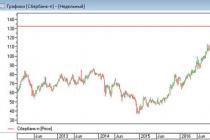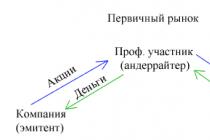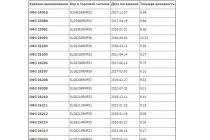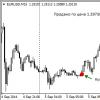Let's look at one of the simplest trend strategies that can be used for intraday trading. Despite its simplicity, it is one of the most effective ways trade.
In fact, it can be used on any timeframe, since the setups on the minute, hourly and daily charts look the same. It is not difficult to understand how this strategy works: we make money when there is a trend movement; when it is not there, we remain outside the market. The best way learn this - .
Practice shows that using this strategy for intraday trading can give 3-4 correct trades per day (sometimes it can be more or less depending on market conditions). Sometimes there are range days. In this case, we will not receive signals to open positions (or there will be very few of them), since the intraday reversal High and Low will not break through, which is evidence of the absence of a trend movement. You need to remain patient and collected. Trade only when the market really offers such an opportunity.
Trading with the trend in the first half of the trading session
Let's take a look at what the beginning might look like. trading session and the first transactions using this strategy:
The day starts, as usual, with jerky movements, but after about an hour, the High or Low of today breaks through.
Now that the Low has been broken, a downward trend line can be drawn. We will look for an opportunity to open a short trade.
After this, we wait for a rollback to the trend line
Please note that the trend line is speculative and has no physical meaning. The main thing in this situation is that during the downward movement, all subsequent reversal Highs are formed below the previous Highs, and the Lows are updated. If these conditions are met, then we have the correct downtrend. For an uptrend, everything should be the other way around.
We go short when the pullback ends. The signal is the breaking of the Low green bar or cluster of bars (i.e. the price falls below the Low of the green bar or cluster of green bars after it has approached the trend line).

After breaking through Low, a downward trend begins.
Enter short on a pullback - on breaking through the Low green bar
Second arrow - similar
The stop is quite short - we place it directly above the last reversal High (in a downward trend). In the first trade (first red arrow on the chart), the High is 117.05. If the price pulls back above this level, you need to exit. The entry point is at 116.91-116.90, that is, immediately below the Low level of the rising bar that approached the trend line. There is no need to wait for the bar to close, because it depends only on the selected timeframe. You only need to look at the real-time price. So we ended up with a stop of about 15 cents.
The target is the last Low minus stop for a downward trend or the last Low plus stop for an uptrend. In this case, the previous Low was at 116.66. Since we have a downward trend on the chart, we can assume that this Low will be broken to some depth. With this strategy, we assume that it will be broken by an amount (at least) of our stop. Therefore, our goal in this case is: 116.66-0.15=116.51. We place a limit order to take profit at this level. As we can see, it works. The profit exceeded the risk by 2.5 times.
The price sets another reversal Low, then rolls back up to the trend line. We do the same thing again, opening a second deal. High - at 116.42, put a stop loss immediately behind it. Entry point is 116.27. The target is 116.11-0.15 = 115.96 (the stop will not necessarily be 15 cents, in this case it is just a coincidence). This time, the reward to risk ratio is 2:1.
Usually on intraday trend you can take 2-3 trades. If the trend is strong, then more. When the market continues to form declining Lows and Highs, you can open a couple of additional positions. But this rarely happens; more often the trend is broken by a deep correction.
If the movement looks too jerky, it is better not to enter. This often happens between 11 and 13 New York time. This does not mean that there are no good movements, but the probability of making the described transactions is reduced.
Trading with the trend in the second half of the trading session
Now let's look at working on this strategy in the afternoon. The horizontal line on the chart marks the Low of the current day. After lunch, this Low breaks through (around 115.50). Let's repeat the process:
Now, after breaking through the main Low, you can draw a trend line (before this, the market was moving in a horizontal corridor - range).
We expect a rollback to the already drawn trend line. Be patient: it is better to miss a trade than to enter too early and have a stop loss that is too large.
We enter short using the criteria described above.

Green arrow - optional trade.
Risk too great due to large reversal bar
The chart shows an “optional” long trade. The price formed a rising Low and a rising High, which allowed us to draw an uptrend line. At the next correction, a rising Low appears, giving us a potential entry opportunity. But at the reversal point the bars are too big. If you look closely at the chart, you can see that the stop would have been between 25 and 35 cents (it is difficult to determine the exact entry point). Such a stop is unacceptably large, and the entry point is “dirty”, so it is better to refuse such a transaction. Moreover, at that time such a deal would have been contrary to the general “mood” of the day. If the risk is too great in relation to the expected profit, you should not open a position either.
And indeed, the market does not go up, but again draws a falling High and a falling Low. Another potential short entry is marked on the chart with a red arrow. The target level has been reached. But in reality, this deal does not fit the strategy in question. The fact is that during this period of time the market is not in a trend movement, but in a transitional state. Try to find the difference between this transaction and previous ones. If you succeed, then you understand the concept of this strategy. Our correct entry appears on the next wave, but it leads to a loss. We had to enter on the pullback between the second red and first green arrows, but we would have been knocked out by the stop.
After this, SPY forms a series of rising Lows and Highs, which gives us 4 points to enter a long position with a stop of about 15 cents and an acceptable profit potential. It is rare when a movement allows you to complete 4 trades. So you shouldn't count on it. After just two transactions, the chances of success begin to decline. The likelihood of experiencing a loss increases as the trend develops. But if the market gives, you need to trade..
Stay up to date with everyone important events United Traders - subscribe to our
Trend trading is one of the most effective trading systems in the Forex market. However, the popular and tired expression “Trend is your friend,” which theoretically does not raise any objections, is not always possible to implement in trading practice, especially for novice traders, and these trading strategies, especially identifying signals to enter a position, require a certain level of knowledge.
What should be the approach to trend trading?
First and most importantly, it is necessary to timely and correctly identify directional movement on the chart. It is advisable to use a comprehensive market analysis and a certain set of tools technical analysis(graphical analysis, data from technical indicators).
It is not enough to simply draw a trend line. You must not only state the presence of directional movement in the market, but determine the nature (long, medium, short-term trend), phase, direction, strength, nature of interaction with the most important levels support/resistance, the presence of graphic figures, and so on. It is very important to determine the directional movement at different time intervals and their relationships.
After identifying a directional movement, the trader needs to focus on signals to enter trading position. Entry signals can be very different, depending on the trading system used. It is necessary to clearly understand that directional movement is always determined on longer time frames, and trading is carried out on smaller time periods, but always in the direction of the prevailing directional movement. That is, if you trade intraday, the trend on the daily charts should be taken as a basis.
Basic trading systems, signals and market entry points
Trading on pullbacks of directional movement. It is the most commonly used method of trend trading. However, trading with a trend does not mean at all that a trader can enter the market in the direction of market movement at any arbitrarily chosen point. As you know, a trend never develops in a straight line, but is accompanied by frequent rollbacks (corrections).
Therefore, when trading based on market movement, the best option is to enter the market after a correction, provided there are signs of a restoration of directional movement, since in practice it is very difficult to determine and distinguish a correction from a trend reversal.

The most effective and simple strategy for trading pullbacks is to buy or sell financial instrument near the support/resistance level. Moreover, the best option for entering a position is the third touch of the resistance/support lines.
Such a line can be either trend lines drawn by the trader or moving average lines, which are selected individually for a specific trading time interval. For these purposes, you can use either one moving average line or several, receiving additional signals at their location in relation to each other, as well as at their intersections.
Both average moving lines and support/resistance levels work well in this strategy, so there is no fundamental difference when using them. Only important point is the selection of the period of moving averages, and they need to be selected for each currency pair individually.
When using such strategies, and there are many of them, it is highly desirable to use various technical indicators (RSI, MCAD, oscillators), which allow you to additionally see the end of the trend rollback and the beginning of the restoration of price movement in the original direction. Experienced traders In addition, they use Fibonacci levels, Price Action patterns and candlestick models.
After entering a trading position, a Stop-loss order is set, which allows the trader to control potential losses. At correct definition directional movement and entering the market, the position can be maintained for a long time. Or, the trader can partially take profit and leave the rest of the position on the market in anticipation of a long-term strong movement.
Entering a trading position when the price extremum is broken
A signal to enter a trading position appears after the rollback is complete when the price reaches and breaks through the level of the previous maximum/minimum price (extremum). It is preferable to enter with a pending order with the obligatory installation of stop-loss orders at a distance in accordance with the risk management system you use.

Additionally, it is also recommended to use in the trading system technical analysis tools – moving averages, various technical indicators that provide the trader with important information about the strength and direction of the trend.
Trading with the trend based on the formed graphic figures of continuation of the directional movement
The trend movement of the price of a financial instrument in the Forex market periodically loses and receives a new impulse of movement, and the directional movement periodically, for some time, is in a state of market consolidation, while forming various patterns of continuation of the directional movement. Such figures include flags, rectangles, wedges, and differently oriented triangles.


Each of the listed figures for the continuation of a directional movement is strictly specific, both in the process of its formation and the rules for entering a trend based on it. Therefore, novice traders are required to carefully study these patterns and apply them in their trading.
Thus, a trader can successfully trade with the trend using various systems entering a directional movement, as well as combining them, thereby reducing the risk of losses. In practice, the basis of trading should be developed by the trader trading system, configured for a specific time period and a specific financial instrument.
It should also be noted that long-medium-short-term trends may be present in the market at the same time, and the trader needs to decide which of them he is trading on. Very important for successful trading maintaining strict discipline and the ability to wait for a favorable situation to form on the market and clear, confirmed signals to enter a position.
Today we have a video for dessert: Microsoft Intensive Training “Investing for an IT Startup”
Today we’ll talk about trends in binaries. I’ll say right away that the information is complicated. It won't be easy for you. When was it simple? That's the theme. In short, I’m starting to share my knowledge and experience on this topic. Go!
Most of the strategies used are designed for investors with a certain level of training, to an ordinary person you will have to spend a lot of time to understand the principles of their operation.
Meanwhile, any strategy is based on the trend - the direction of the price.
Trend trading with binary options involves the use of dozens of strategies and analysis tools.
One of the rules of professional trading that cannot be broken is the rule: do not go against the trend.
It is necessary to be on friendly terms with the trend; trading should be carried out only in the direction of the trend. 
Therefore, among the questions asked by beginners, there is often a question: how to determine the trend in binary options?
Widely used to determine trends two types of tools:
- Lines, characterizing price movements.
 photo – forexspamm.ru
photo – forexspamm.ru - Trend indicators for binary options.

There are two main types of trends: upward and downward.
- Ascending is a series of increasing max and min values. At the same time, all subsequent ones are located above the previous ones.
- Descending ones are also series from the minimum and maximum values, but each subsequent one is located below the previous one.
For greater visualization of these processes, their schematic designation in the form of trend lines is used.
Particularly effective when correct use turns out to be a strategy that takes into account the movement of the lines of these lines, which are considered one of the main tools of analysis.
They greatly simplify the process of determining the width of the corridor and the direction of price movement.
As I said above, there are two types of lines: ascending (resistance) and descending (support).
The resistance line is located at the top of the price chart and runs along the top price indicators for the selected time period. It concerns peak values.
The support line is located below and describes the movement of the minimum price indicators in certain period. It is carried out between two price minimums.
I wrote a lot about these two lines here - - so I recommend reading it, it will become clearer using my analytics as an example.
The possibility of the formation of these straight lines is an indicator of the existence of a trend that must be taken into account in trading.
To draw a line and use this tool, you must have at least two points - maximum or minimum indicators, which can be connected by one straight line.
There are clear construction rules that also characterize the level of reliability:
- The big point is the degree of inclination. Strong tilt is an indicator of unreliability.
- More convincing lines built a couple of points. With a larger number of points, reliability will decrease and the probability of breakdowns will increase.
- One should not strive to carry out the construction in all circumstances of the market, a situation in which all attempts to draw end in failure means that there is no trend. It follows from this: a situation has arisen that is not suitable for using the tool.
What I'm talking about today:
Trading options with trend using lines
In practice, two methods with fundamental differences are actively used:
- Using a line (support or resistance) to move in the direction of the trend.
- Play using the breakout line, reversing the trend.
 Both methods have certain advantages, but you should learn to use them correctly.
Both methods have certain advantages, but you should learn to use them correctly.
The first method is often perceived by many as simpler. To implement it, a straight line is built along a couple of points.
This method is simple and easy to use.
When using it, it is necessary to take into account: if the price often touches the line, then there is high probability of breakdown. It is possible that it will happen the very next time you touch it!
If the line is quite flat and long, then after its breakdown in many cases the trend changes.
When playing for scrap, you should do this:
- wait for touch:
- wait for the rebound;
- after the tick is formed, place a “buy” order, “sell stop”.
When the price reaches the line and crosses it, you will need to wait for its movement to change in the opposite direction in order to place an order at its maximum point at that moment.
After this, a short period of time will pass before the order is triggered and you can enter the market.
It is important to wait for that moment to enter. Without doing this, you cannot be completely sure that testing the trend line will be of high quality. By waiting until the tick is ticked, you will increase the likelihood of profit by weeding out unnecessary signals.
This technique, at first glance, is perceived as understandable and accessible to practical application, but it has many subjective aspects.
A trader may encounter a number of difficulties.
For example, it is necessary to mandatory take into account the angle of inclination of the constructed line. It can be different, which determines the stability of market trends. Without proper experience, you can draw a line at too sharp an angle and lose your invested funds.
Another important point in analyzing this type of chart is that you should be careful about breakouts. 
It is not always easy to determine from the first time which chart indicators can be considered a breakout and which cannot, how many points the price should rise to be considered a breakout.
The trading process is developing very dynamically. Indicators quickly lose their significance and become outdated.
It is important to determine in time the moment when a trend becomes outdated and it is time to build a new line.
This trending binary options strategy requires the acquisition of certain practical experience. It is impossible to use a few theoretical rules to achieve regular positive results.
What is theoretically expressed in clear, simple formulations, in practice it often doesn't work.
It is for this reason that line indicators have not yet been created; even if they exist, in practice they too often produce erroneous constructions.
The strategy is designed for the skill of the trader.
Fine mastery of this method implies its use in a wide variety of situations. It is not necessary to use this method constantly; it often shows the greatest effectiveness as an adjuvant.
Indicators for trading
If you are interested in trading options with the trend, Russia offers a market replete with various brokerage firms, whose arsenal contains all the necessary tools.
Successfully making a profit using these tools implies that the trader must use all existing resources and opportunities. In particular, acquire the skills of performing technical analysis.
Technical analysis methods are accessible to the beginner and allow access to very accurate forecasts. With this accurate information, you can make great strides in achieving income acquisition.
Among technical analysis tools, those based on the use of indicators are widely used.
Indicators are especially popular due to the same properties as technical analysis: they are easy to understand and easily adaptable to practical activities.
At the same time, they allow you to achieve increased efficiency of actions, allow you to take steps without additional, in-depth study and experience.
They are available for use immediately after the start of trading activities, are offered in large quantities, and are used as high-quality tools for implementing a wide variety of strategies.
Trend indicators are used to calculate the direction of trends.
Trend trading on binary options, the strategy of which involves monitoring price movements, allows for trend analysis using a number of indicators.
All of them are considered to be quite inert and provide information with a slight delay. Based on them, they track the state of price movement trends that happened in the past or at the present moment. Despite this, such indicators help avoid large quantity false signals and predict the course of market development.
Bollinger indicator

 Time-tested and distinguished by excellent performance in the modern market environment.
Time-tested and distinguished by excellent performance in the modern market environment.
It is built directly on the price chart and has appearance of three wavy lines.
When observing it, you should pay attention to the price chart, if it rises above the upper wave - this is an indicator of the beginning of the growth of an uptrend. When moving beyond the bottom, a downward movement is observed.
When it is located in the middle area, the market is called flat. Some traders focus on trading specifically with this type of market, while all others are in standby mode.
I did analytics on Bollinger here - - OH, AND IT WAS DIFFICULT FOR ME! But he seems to have written it in an accessible way.
MACD
Represented by two variations: MACD, MACD histogram.
The regular option is almost no different from Bollinger in its graphical appearance and location. The histogram is designed as an independent graph, where the trend is expressed in the form of vertical bars of various lengths. The length is proportional to the strength of the trend.
Placement of dashes above and below horizontal line indicates, accordingly, the type of trend.
If you want to optimize your activity using MACD, then keep in mind that it performs best on large time intervals. but on short and five-minute periods it malfunctions.
Ichimoku indicator
 Photo — lovedengi.ru
Photo — lovedengi.ru It often seems complicated at first, but Particularly attractive due to its precision. It consists of five lines that form a variety of signals due to the shapes of their intersection. If the indicator is lined up on a chart, then intersections with the chart line are also clues.
A large number of lines allows us to call this indicator self-checking.
Only if all received signals confirm each other, does it make sense to purchase an option.
Most often used for large scales, since its main task is to determine the trend.
With a large trend, this task is easier to implement.
Oscillators
These are indicators of a separate category.
If in Forex it is necessary to take into account the number of points passed by the price, then for options this indicator is not important.
Enough information about the change by 2-3 points to make a decision that will bring profit.
Oscillators do an excellent job with this task.
Stochastic
It has been in demand for many years, as it is designed for activity in the “channel” market.
It itself is a channel limited by upper and lower rulers.
If the chart goes beyond the top, it is an indicator of overbought.
Moving below the bottom shows that the market has been oversold, prices are more likely to rise.
This approach is relevant only when the trend is not expressed.
In the process of using indicators and trend strategies, it is important to clearly understand the principle of their operation. Only then can you count on success. In general, with competent, thoughtful organization, these tools are a sure help in trading activities.
Let's finish for today. Madhouse, isn't it? I understand you perfectly. When I first encountered indicators, I almost went crazy. Time passed and it began to dawn on me. Well, we’ll “get to the bottom” together, gradually. As soon as you understand this material, immediately... It is available here. Bye everyone!
Hi all! Andrey is with you, and today we will talk about how trend trading occurs. After studying the proposed material, you will know how to determine the direction of the trend using various tools and methods of technical analysis. Since the article will a lot of practical material, I recommend you do the following:
- add the page to bookmarks;
- write down all the suggested tips that you can use in practice;
- Necessarily watch the video tutorials and complete All tasks that are in each block of the article.
In this small publication I tried to collect maximum of simple and useful recommendations, which can be immediately applied in real market conditions.
Test drive your knowledge
Below are four test questions that cover how to draw a trend line and use it to determine market direction. Please read them attentively and try to give maximum amount exact answers. The correct options are published at the end of the article.
1. Why is a trend line needed?
Write down your answer on a piece of paper.
2. Imagine that you have two trend lines: the first connects five lows, and the second connects two. Which one is more important?
A. First
B. Second
3. Determine in which of the listed cases the Forex market has established flat
A. Calm movement with reduced volatility of the selected asset
B. No new price extremes are formed on the chart over a long period of time
WITH. The price stopped between two moving averages with periods of 10 and 50
4. What do you call a market situation when several consecutive highs are formed on the chart?
A. Uptrend
B. Compression ( flat)
WITH. Market reversal
If you have any difficulties with at least one question, then I recommend that you temporarily stop trading on a real account and learn the theory for a couple of months. Perhaps this is the main reason that you do not know how to determine the trend and make money on your knowledge.
What is a trend and how does it happen?
Let's start with the basics. Below you can see three market situations that are present at all time intervals of any financial asset.
About 70% of the time the price is in a sideways state. At this moment, a balance of supply and demand is formed between all market participants. Conduct transactions at such moments unsafe, since no one knows in which direction the next price jump will occur.
Watch the following two videos, which detail the types of trends present on all exchange platforms in the world.
Lesson #1
Lesson #2
Exercise
Open the chart of any trading asset and learn visually determine upward, downward and sideways trend.
Why is it important to track the trend and trade in time with the market?
There are three main rules in technical analysis, which any stock exchange school introduces to all beginners.

Pay attention to the second postulate. Two additional regularities follow from it, which must take into account every trader:
- The price has more chances to continue moving than to change the chosen direction;
- The development of a trend will not stop exactly until the moment when signs of reversal.
If we talk in simple words, then you can earn big money only during a period of directed trend movement. It is also possible to make a profit on trend reversals and during a sideways market, however, for this you need experience and sound strategy. Unfortunately, such schemes are almost impossible for beginners to implement.
This video explains how to use Various types strategies on the stock exchange.
Exercise
Choose your future concept trading strategy. Think about how you will trade: along the trend, during a flat period or against the main trend.
What timeframe to work on
See the direction of the market on the time interval in which your trading strategy is being implemented.
For a more detailed explanation of this circuit, see the video.
Exercise
Determine the time interval, where you will track the trend.
Best Ways to Determine Current Trend
There are more than a hundred techniques that allow you to understand the direction of the market trend. Below we will only list five simplest and most effective. Whatever option you choose, always remember the main diagnostic rule: if you do not understand which direction the market is moving, it means it is in a flat state.
Drawing trend lines
Rising movement:
- increase;
- Connect the desired areas with the " Trend line».
Downward movement:
- Find two neighboring points that are consecutive are decreasing;
- Connect the desired areas with the "Trend line».
Alternatively, download trend line indicators and just wait for them to do the marking for you.
In this video you will learn how to add a trend line to a price chart and use it to get necessary market information.
Using Technical Indicators
- Open MetaTrader 4 or another terminal with which you will work;
- Go to the section " Indicators" - tab " Trending»;
- From the available list, select any instrument that will send you signals about the current market situation.
In this video you will learn how to determine the trend using popular technical indicators.
Support and resistance levels
Upward movement:
- resistance levels;
- If the price consistently overcomes level after level, it means there is a stable trend in the market.
Downward movement:
- Find several nearest ones on the graph support levels;
- If the price consistently overcomes level after level, it means there is a stable trend in the market.
When there is a trend in the market, the price movement resembles jumping on steps:

Defining four control points
- maximums.
- Look at the direction of the last two minimums.
Growing Market:
- up;
- Each subsequent extremum higher previous one.
Falling market:
- Highs and lows are directed down;
- Each subsequent extremum below previous one.
Flat:
There is no clear direction in the market or all control points are in the same level range.
More detailed description For this method, see the following video.
Viewing a higher timeframe
- Go to the time slot that 3-6 times higher than your working timeframe;
- If the trend ascendingraising the top and bottom;
- If the trend descending, then a smooth step-by-step lowering the bottom and top.
For more information about this method, see the following video.
Exercise
Choose any one method by which you will determine the trend.
How to determine the strength of a trend?
Using this indicator, a trader can understand how long The current market situation will continue. The weaker the trend, the greater the likelihood of an early reversal (and vice versa).
Let's look at a simple way to effortlessly determine the strength of the trend.
- Open the trading terminal;
- Go to the section " Indicators»;
- Add ADX.
Watch the following video which goes into detail about how to determine the strength of a trend in Forex.
Exercise
Find in trading terminal ADX indicator and learn to use it to determine market power.
How to use a trend?
We mentioned earlier that there are three basic approaches that allow you to use the current trend. Review them again, and based on one of the listed methods, make sketch of your trading system.
Trading on pullbacks | Finding Pivot Points | Opening trades in a narrow price range |
|---|---|---|
| You determine the direction in which the market is moving | You define the trend | Are you watching a trend develop? |
| Wait until the price enters the correction phase | Waiting for signals indicating a market reversal | Waiting for the price to enter the consolidation phase |
| When movement in the direction of the main trend resumes, you enter the trade | Enter a trade against an established trend | Proceed to opening trades within the trading channel |
How to Trade Market Pullbacks
How to determine a trend reversal
How to make trades during a sideways market
Exercise
Make a rough outline of your future trading strategy.
What should a newbie do?
Start trading market pullbacks and follow the trend. Once you learn how to make money this way, you can expand and use more complex algorithms. Until this moment, forget about exoticism and all adventurous experiments..
Preparatory part
- Choose any asset you like;
- Set a four-hour timeframe;
- Add two indicators to the chart: Bollinger bands And ADX.
Schedule after completing all preparatory steps:

Purchase
- The price is located between the top and middle Bollinger stripe bands;
- The main ADX line is rising;
- Bullish Engulfing»;
- In one position do not invest more than 3% of the account.
Here is the four-hour timeframe of the GBP/USD pair. After entering the trade, we placed Stop Loss at the level 90 points, A Take Profit made up 270 points

Sale
- The price is located in the interval between the lower and middle Bollinger bands;
- The main ADX line is rising;
- The price made a correction to the middle Bollinger band and formed candlestick pattern « Bearish engulfing»;
- We buy on a new four-hour candle;
- Stop Loss is set in the range of 60-100 points, Take Profit is 3-5 times more than Stop Loss;
- We do not invest more than 3% of the account in one position.
Here is the pair's four-hour timeframe GBP/USD. After entering the trade, we placed Stop Loss at the level 80 points, A Take Profit made up 240 points, identify the shortcomings and get rid of them.
Personal observations
When you trade for a long time, you begin to understand why the majority of traders lose money. Below you can familiarize yourself with the main patterns that many users simply do not want to notice.
- The market doesn't care how you built the trend line;
- Whatever the strength of the trend, nothing prevents it from turning around and starting to move in the opposite direction, and then returning to its starting point in a few seconds;
- Any forecast made is just assumption, which has no guarantees for implementation;
- The market is constantly looking for money, so the movement is always directed against the majority;
- If your Take Profit is several times greater than your Stop Loss, then even with a low percentage of profitable trades you will be able to receive a stable income; ;
;
.Checklist
Below is the entire list of tasks that you would like to complete. for a complete mastery of the topic discussed.
- Open the chart of any trading asset and learn to visually identify upward, downward and sideways trends;
- Choose the concept of your future trading strategy. Think about how you will trade: along the trend, during a flat period or against the main trend;
- Define time interval, on which you will track the trend;
- Select one the way you will determine the trend;
- Find the indicator in the trading terminal ADX and learn to use it to determine market power;
- Make a rough sketch of your future trading strategy;
- Test your trading methodology on 40-70 trades, identify shortcomings and get rid of them;
- Test your strategy again and get ready to work with a real deposit.
P.S. Answers to the test
- Using a trend line, a trader can project the path that the price will follow in the future. Additionally, it acts as a reference level, which is equivalent to support/resistance.
- A. The line connecting the five minimums is much stronger than the one that withstood only two contacts with the price. The greater the number of touches, the higher the value of the level involved.
- B. If no price highs or lows are formed over a long period, this means that the chart is enclosed in a fixed price range with a maximum upper and lower point. This consolidation is called flat and indicates a balance between market sellers and buyers.
- A. Two consecutive maxima is a classic definition that is typical for rising trend movement.
If you find an error in the text, please select a piece of text and click Ctrl+Enter. Thanks for helping my blog get better!
















